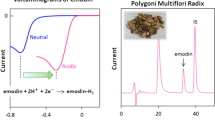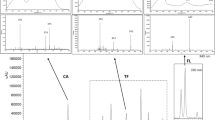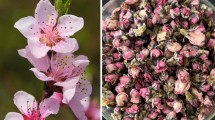Abstract
A uniform experimental design procedure was used to investigate the effects of some operating parameters on the extraction of emodin from Polygonum cuspidatum Sieb. et Zucc. products. Variables tested were volume ratio of material to solvent, size of material, extraction time and temperature and composition of extraction solvent (mixtures of acetone-water). Each variable was tested at seven levels; 7 experiments were performed in random order. Analyses of the extracts were performed by high-performance liquid chromatography with diode array detection(HPLC-DAD). Analytical responses were processed by using a forward regression analysis, in order to find polynomial function describing the relationship between variables and responses. For all the analytes the experimental conditions for providing the highest extraction yield inside the experimental domain considered were found. Finally, a simple, rapid and accurate analytical method was developed for the determination of emodin by high performance liquid chromatography. The separation is achieved within 25 min on an ODS column using methanol and water as gradient mobiles. Emodin can be quantified by using external standard method detecting at 436 nm. Good linearity is obtained with correlation coefficient exceeding 0.9986 and the detection limit and the quantification limit are 1.53 and 3.23 mg/L respectively. This method shows good reproducibility for the quantification of the emodin with intra-day and inter-day relative standard deviation less than 2.3% and 5.6% respectively. Under optimized extraction conditions, the recovery of the standard is 96.5%. The validated method is successfully applied to quantify the emodin in seven Polygonum cuspidatum sieb. Et zucc. products, which provided an idea for the pre-treatment of determination of active compounds in traditional Chinese medicines.
Similar content being viewed by others
References
LIAO Xing-yuan, TANG Xin-de, ZENG Fan-bo. Anti-tumor pharmacology study of emdin in P. cuspidatum[J]. Chin Hosp Pharm J, 1988, 8(5): 214.(in Chinese)
WANG Yu-sheng. Pharmacology and application of traditional Chinese medicine[M]. Beijing: People’s Medical Press, 1983. (in Chinese)
China Pharmacopoeia Committee. Chinese Pharmacopoeia[M]. (Vol.1). Beijing: Chemical Industry Press, 2000.(in Chinese)
YAO Chun-yan, LIU Wen-zhe. Seasonal change of anthraquinone in vegetative organs of Polygonum cuspidatum[J]. Acta Bot Boreal Occident Sin, 2005, 25(1): 179–182.(in Chinese)
WANG Jin, XIA Du-lin, AN Zi-zhao. Research on the content measurement of polydation and emodin of huzhang tablet[J]. J Hunan Industry Polytechnic, 2003, 3(4): 13–14.(in Chinese)
WAN Jing-xia, XU Jia-luan. Determination of total anthraquinone in ethonal extract of Polygonum cuspidatum[J]. Chin J Modern Appl Pharm, 2004, 21(4): 284–285.(in Chinese)
ZHONG Ping. Determination of emodin and physcion from Polygonum cuspidatum[J]. Henan Pharm Information, 2002, 10(10): 9–10.(in Chinese)
YUAN Ke, YANG Zhong-han, YIN Peng-hui, et al. The process choice of rhizome poizoma cuspidatum extracted substance and quality analysis[J]. Chin J Modern Appl Pharm, 2000, 17(6): 444–446. (in Chinese)
JIANG Hai-ren, ZHU Hua, HUANG Hui-xue, et al. Effects of processing on piceid and emodin in Polygonum cuspidatum[J]. Chin Traditional and Herb Drug, 2003, 34(5): 412–415.(in Chinese)
LIU Xuang-xi. Huan J. Determination of emodin in Fufang-huzhangqudu capsule[J]. Traditional Chin Med, 2003, 19(3): 57–58.(in Chinese)
YANG Shi-xi. Determination of emodin in Jinhubaogan granule by TLC[J]. China Pharmacist, 2005, 8(2): 138–139. (in Chinese)
Li Y, Liu H, Ji X, et al. Optimized separation of pharmacologically active anthraquinones in Rhubarb by capillary electrochromatography [J]. Electrophoresis, 2000, 21(15): 3109–3115.
Li W, Chan C L, Lueng H W. Liquid chromatography-atmospheric pressure chemical ionization mass spectrometry as a tool for the characterization of anthraquinone derivatives from Chinese herbal medicine[J]. J Pharm Pharmacol, 2000, 52(6): 723–729.
Weng W C, Sheu S J. Separation of anthraquinones by capillary electrophoresis and high-performance liquid chromatography[J]. J High Resol Chromatogr, 2000, 23(2): 143–148.
Sheu S J, Chen H R. Simultaneous determination of twelve constituents of I-tzu-tang, a Chinese herbal preparation, by high-performance liquid chromatography and capillary electrophoresis[J]. J Chromatogr, 1995, 704(1): 141–148.
Okamura N, Asai M, Hine N, et al. High-performance liquid chromatographic determination of phenolic compounds in Aloe species[J]. J Chromatogr A, 1996, 746(2): 225–231.
Sheu S J, Lu C F. Determination of eight constitutes of Hsiao-cheng-chi-tang by high-performance liquid chromatography[J]. J Chromatogr A, 1995, 704(2): 518–523.
Tóth Z A, Raatikainen O, Naaranlahti T, et al. Isolation and determination of alizarin in cell cultures of Rubia tinctorum and emodin in Dermocybe sanguinea using solid-phase extraction and high-performance liquid chromatography[J]. J Chromatogr, 1993, 630(2): 423–428.
Fang K T, Wang Y. Number theoretic methods in statistics[M]. London: Chapman & Hall, 1994.
FANG Kai-tai, MA Cheng-xing. Orthogonal and uniform experiment design[M]. Hongkong: Hongkong Baptist University, 2000. (in Chinese)
WAN Jing-xia, XU Jia-luan, ZHU Xing-yan. Determination of emodin in Polygonum cuspidatum[J]. Chin J Exper Traditional Med Formulae, 2005, 11(3): 17–18. (in Chinese)
Author information
Authors and Affiliations
Corresponding author
Additional information
Foundation item: Project (04JJ3081) supported by Hunan Province Natural Science Foundation of China
Rights and permissions
About this article
Cite this article
Lu, Hm., Liang, Yz., Ni, Wd. et al. Optimization of extraction and determination of emodin from Polygonum cuspidatum Sieb. et Zucc. products by HPLC-DAD. J Cent. South Univ. Technol. 13, 658–662 (2006). https://doi.org/10.1007/s11771-006-0011-y
Received:
Accepted:
Published:
Issue Date:
DOI: https://doi.org/10.1007/s11771-006-0011-y




